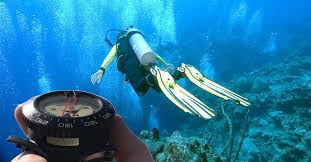Underwater Navigation: From Follower to Explorer
Have you ever surfaced and wondered, “Where’s the boat?” It’s not a comfortable feeling. Underwater navigation skills are the antidote to that uncertainty. This is the second mandatory dive in the Advanced Open Water course, and it’s perhaps the single most confidence-building skill you can learn.
This Amadive article will show you the importance of navigation and the techniques you’ll learn to turn every dive into a purposeful journey.

1. Why is Navigation So Important?
- Safety: This is the number one reason. Being able to reliably return to your exit point (boat or shore) minimizes risk and stress.
- Efficiency: When you know where you’re going, you don’t waste time and air swimming in circles. You get to see more of the dive site on every dive.
- Confidence: The feeling of knowing exactly where you are and being able to lead a dive is priceless. It transforms you from a passive follower into a proactive dive buddy.
2. Your Navigation Tools
Underwater navigation is a combination of two methods: using tools and observing nature.
A. The Compass
Your compass is your best friend underwater. You will learn to:
- Use it correctly: Hold the compass level and flat, keeping the lubber line aligned with your body.
- Set a heading: Point the compass towards your destination and turn the bezel to mark your course.
- Set a reciprocal heading: Easily find your way back by using the 180-degree markers on the bezel.
B. Natural Navigation
This is the art of reading your surroundings:
- Depth: Following a contour line (e.g., staying at 15 meters) can lead you parallel to the shore.
- Sunlight: The direction of the sun and shadows can be a good guide.
- Bottom Topography: Use unique features like a large coral head, a rock outcropping, or a sand patch as “road signs.” Create a mental map.
3. Skills You Will Practice
During the Navigation Adventure Dive, you will practice:
- Swimming a straight line and back using your compass.
- Navigating a complete square or triangle pattern.
- Estimating distance by counting kick cycles.
- Combining both compass and natural clues to find your way to a specific spot and return.
Conclusion
Navigation isn’t magic. It’s a learnable skillset that will completely change the way you dive. It provides freedom, safety, and a new level of confidence, allowing you to truly begin exploring the underwater world on your own terms.
➡️ Now, let’s fine-tune the most important skill for becoming a graceful diver in our next article: The Art of Peak Performance Buoyancy (PPB)
